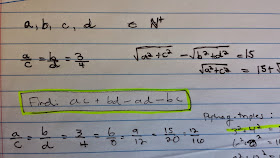 |
| Click on the picture to expand! |
The first thing I did was re-write all of my parameters on paper. I know that I'm looking for the positive integers a, b, c, and d that fit all of these equations. Next, I wrote out equvalent fractions for the (a/c) = (b/d) = (3/4) requirement. I realized that each of these are 2/3rds of a Pythagorean Triple, which fit well with the square root portion of the equations.
Next was time to determine which integers from the fractions to use for each variable, so I listed out the first few Pythagorean Triples of the form x2 + y2 = z2.
I knew from the given equations that I'm looking for a pair Pythagorean Triples whose z- value difference is 15. I chose the triples (of form x2 + y2 = z2) where z = 5, and where z = 20. I then decided which integer from the Pythagorean Triples would represent each of my variables from the problem. The pair a,c had to be from the triple with larger values, and c had to be the larger of those two.
Then, after quickly confirming my variables in the 2nd to last line of the problem, I plugged my variables into the equation ac + bd - ad - bc to find my final answer: 108.
Have a great Monday everyone, and as always, please leave a comment if you have any questions about my solution.
-Tori
UPDATE: One of our followers on Twitter sent us a picture of his geometric solution to the problem. It's always interesting to see the same problem done in a different way. Check it out below, and thanks, Alex!
@centerofmath a geometric solution (see my comment on the blog) pic.twitter.com/nSHkiD1jh7
— Alex (@quintic3fold) May 11, 2015


The first time I did this problem when The Center of Mathematics some time ago, I did this by "brute force" (straight out calculations/variable substitution/algebra). I never thought about the Pythagorean Triples angle.
ReplyDeleteGood catch! This is an older Problem of the Week that a past intern originally posted. I recycled it because it generated a lot of buzz, but didn't have a solution on the blog yet.
Delete-Tori
Nice. There's a more geometric way to see this. Think of (a,c) and (b,d) as vectors in the plane. The equation a/c=b/d=3/4 tells you that they are colinear, with gradient 3/4. That is to say, they both form hypotenuses of 3:4:5 triangles.
ReplyDeleteThe expression sqrt(a^2+b^2) - sqrt(b^2+d^2) is the difference between the lengths of these two vectors. Hence we are looking for a 3:4:5 triangle with hypotenuse of length 15. This triangle has side lengths 12 and 9.
The expression ac + bd - ad - bc = (a-b)(c-d) is the area of the rectangle whose diagonal is our hypotenuse of length 15. Thus ac + bd - ad - bc = 12*9 = 109.
woops 12*9 = 108, not 109 obviously.
Deletealso i tweeted you a picture to accompany this